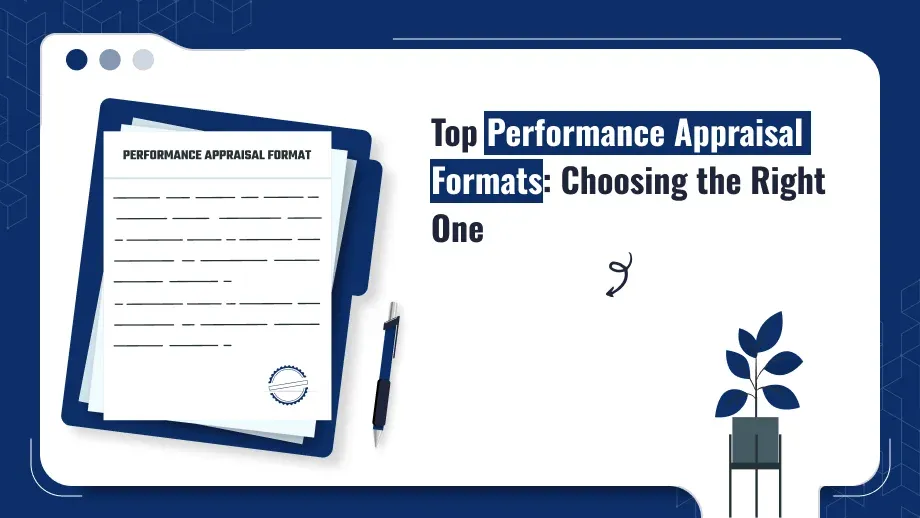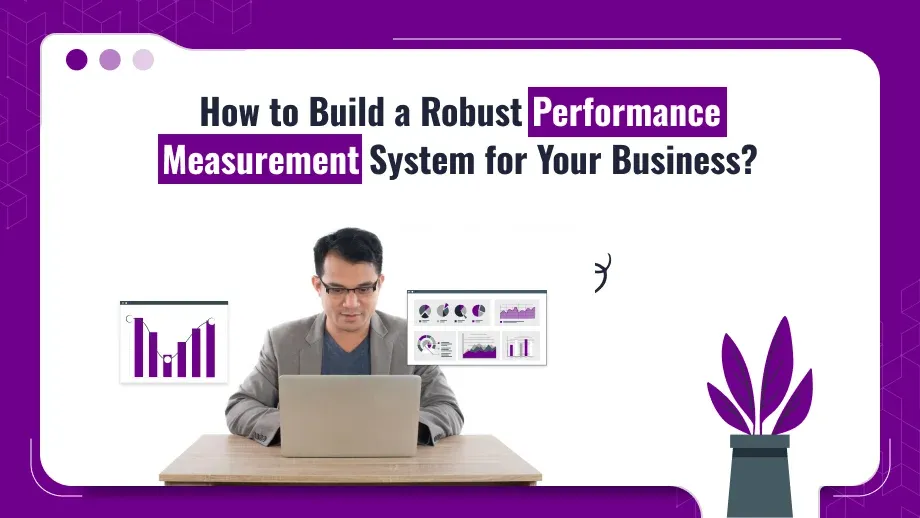
There isn’t a universal method to evaluate the performance of employees. The way in which your team’s reviewing process functions is contingent on the style you employ for the performance review. Giving feedback, motivating your staff and coordinating their efforts to the objectives of your company is all possible when you use the right performance appraisal format.
We’ll go over several of the most popular types of performance appraisal format reviews in this post, and help you in choosing the one that is most suitable on your team. Whatever your team needs a simple evaluation system or an more extensive 360-degree feedback This article will assist you in choosing the most appropriate one.
Why the Right Performance Appraisal Format Matters
Selecting the best form of performance appraisal is an important decision that will determine how your employees can be aligned with your company’s goals. Performance appraisals aren’t only measuring employee performance or behaviour. It’s also a method to strategic performance, with the goal of the individual’s efforts contributing towards the organization’s longer-term objectives.
Forms of appraisal for performance affect the way employees view their roles as well as their role in the overall success of the business. When you pick a style that includes components of a strategic approach to strategic performance management is not just an evaluation of past tasks, but helping to guide your future performance to a path which is in line with your company’s goals and mission.
For HR and managers the right appraisal format ensures every evaluation is fair, structured and aligned to both individual goals and performance strategies.
This establishes a direct relationship between a worker’s day-to-day work and the company’s goals. In the scenario of a business which is driven by the pursuit of innovation, appraisals must include the measures of innovation, problem-solving and the application of new strategies. If efficiency in operations is crucial to success, the structure could focus on productivity as well as time management, the improvement of processes.
Incorporating strategic performance management into the appraisal process ensures that it’s not only evaluating the work of employees, however, but also where they’re supposed to improve their performance. Managers and executives are able to keep track of their progress at a moment’s notice and pinpoint areas in which further training or help is needed.
Furthermore, a properly constructed appraisal structure ensures that performances reviews are consistent throughout the entire organization and fair, as well as without bias. Employees are more aware of the contribution they make to the overall success of the organization which increases satisfaction and motivation. Managers may use these models for more effective reviews, connect performance with particular outcomes, and set goals for the company.
Including strategic performance management in appraisals ensures every employee is working towards the same overall goals. It also gives you an opportunity to highlight areas where individuals can grow and have a more effective and engaged workforce. By choosing the right appraisal format you can improve not just individual performance but also organisational performance and long term success.
Top Performance Appraisal Templates
Choosing the right performance appraisal format is key to a performance management process. Different formats suit different team structures and company goals but they all have one goal: align employee performance to the company’s strategic plan. Below are some of the top appraisal formats and when to use them.
1. Rating Scale Appraisal
This type of evaluation is probably the most practiced appraisal formats of all time. Employees are appraised according to the different areas of work performance including management, efficiency, and their ability to work as a team member. This method functions rather effectively in identifying an employee’s strengths and weaknesses. Good for companies that need a simple but effective way to measure performance across different roles.
- Best for: Quick, quantitative measurement of performance.
- Strategic Plan Alignment: This format allows managers to see which employees meet the core competencies required to achieve the company’s strategic plan. For example if innovation is a priority managers can rate employees on creativity and adaptability.
2. 360-Degree Feedback
This format gathers feedback from multiple sources: peers, subordinates, supervisors and sometimes even clients. It gives a rounded view of an employee’s performance and is good for environments where teamwork is key.
- Best for: The companies that are oriented toward capacity development of their managers and teams.
- Strategic Plan Alignment: 360-degree feedback will be for the companies that have a strategic plan of developing strong leaderships or enhancing the dynamics of the teams. It allows managers to comprehend how an employee affects the satisfaction of the company in as far as the objectives of the organization are concerned.
3. Management by Objectives (MBO)
In this MBO style of appraisal, there is collaboration between the party conducting an appraisal and the appraisee to pre-determine a number or targets that will be met in the organization, such targets being individual’s paralinguistic aides to the strategic plan of the organization. After a specified period, usually determined by the strategy of the organization, the employee’s performance is evaluated in relation to those during the period.
- Best for: The companies in which high emphasis is placed on achieving pre-determined targets or objectives and their processes.
- Strategic Plan Alignment: This configuration helps in evaluating performance in such a way that individuals’ targets are realized in the context of the organization’s performance. For example if expanding the operational jurisdiction of the company is the objective so workers’ performance criteria may entail pursuit of opportunities in untapped markets among uch criteria.
4. Self-Assessment
Employees evaluate their own work using this style, and a conversation with their manager typically follows. Employees are encouraged to consider their accomplishments and pinpoint areas for development using this approach.
- Ideal for: Businesses looking to encourage self-motivation and personal accountability.
- Strategic Plan Coherence: Employees can reflect on how their job fits into the company’s strategic goal through self-assessments. Employees can take greater responsibility for their personal growth and better connect their efforts with the objectives of the organization by realizing their role in the larger scheme of things.
5. Competency-Based Appraisal
This method assesses employees on specific competencies or skills required for the role and company success. Good for technical or specialized roles.
- Best for: Companies with specific skill requirements or industries where competencies define success.
- Strategic Plan Alignment: Competency-based appraisals align to the company’s performance management system by ensuring employees develop the key skills needed to deliver the strategic plan. For example if the strategic goal is to improve product development this format can help identify employees who need training in innovation or technical skills.
Improve your appraisal process with a performance appraisal format that drives results.
Download the template and optimize your employee evaluations now!
Tips for Selecting the Best Performance Review Format for Your Group
The performance management strategy used by your business will determine the best format for your performance review. When employee evaluations are formatted properly, they cover future potential as well as how employees fit with the company’s strategic goals.
1. Know Your Team’s Structure and Needs
Your performance management approach should reflect your team. For example if your team works in a highly collaborative environment 360-degree feedback may be the way to go. If your team is individual output focused a simple rating scale may be enough.
- Example: If your team works on cross-functional projects choose a format that includes peer feedback which will highlight teamwork and communication skills.
2. Align to Company’s Strategic Plan
A good performance management approach is aligned to the company’s strategic plan. The appraisal format you choose should help employees understand how their performance contributes to the bigger business goals. For example if your strategic focus is on specific measurable outcomes like sales targets or project milestones MBO works well.
- Example: If your company’s strategic plan includes expanding into new markets the appraisal format should assess employees’ role in driving that expansion, whether through business performance or innovation.
3. Think about the Frequency of Appraisals
The frequency of your performance appraisals should match your overall performance management approach. For continuous development you may need a format that supports more frequent feedback, for example quarterly reviews with simpler self-assessments or 360-degree feedback. If you only do annual reviews you may want a more comprehensive format like competency-based appraisal to cover all performance aspects.
- Example: Fast growing teams may benefit from more frequent shorter reviews to keep employees aligned to the fast changing company priorities so the performance appraisal process supports timely course corrections.
4. Adapt the Format to Employee Roles
Different roles may require different appraisal formats depending on their role in the company’s performance management approach. For example executives may need a more in-depth review, for example competency-based appraisals, that focuses on leadership skills while entry level employees may need a format like a rating scale that highlights learning and growth.
- Example: Use a rating scale for junior employees, focus on basic competencies while senior management may benefit from 360-degree feedback that provides insights on leadership and decision making skills.
5. Feedback from the Appraisal Process
Another performance management approach is to ensure feedback from the appraisal process leads to tangible outcomes. The right appraisal format helps managers and employees have constructive conversations, set clear expectations for future performance. Formats that include development plans or goal setting (like MBO) allow employees to apply feedback to their work.
- Example: After an MBO appraisal managers and employees can set specific measurable objectives that align to the employee’s career path and the company’s strategic priorities.
6. Ease of Implementation
Practicality of implementation is a key factor in its success. Choose a format that fits into your existing performance management approach. While more complex formats like 360-degree feedback can provide rich insights they require more time and resources to manage.
- Example: For a small team with limited HR resources a simpler, more scalable format like a rating scale may be the best option, so performance reviews are consistent and actionable without overwhelming the team.
Mixing Performance Appraisal Formats for Maximum Impact
To get the most out of your performance reviews mixing different appraisal formats can be a good approach. Employee evaluations that are thorough and in line with the organization’s long-term objectives are made possible by a blended approach that supports both performance management and strategic plan.
1.Making use of grading scales and 360-degree comments
You can collect quantitative data and detailed insights from multiple perspectives by integrating rating scales with 360-degree feedback. While rating scales facilitate the rapid evaluation of essential competencies, 360-degree feedback guarantees that employees’ performances are evaluated holistically from a variety of perspectives (supervisors, peers, and subordinates).
Strategic planning is aided by this hybrid method, which provides you with an accurate assessment of staff contributions. Rating scales can evaluate performance indicators like teamwork or decision-making, and 360-degree feedback can assist in identifying potential leaders if your strategy calls for training leaders.
2. MBO and Competency-Based Appraisals
While competency-based evaluations assess certain abilities that support those goals, MBO concentrates on goal-setting that is in line with the organization’s strategic planning. By combining these two approaches, employers can make sure that staff members are not only reaching their goals but also gaining the skills necessary to do so.
Companies that wish to connect individual performance to their overarching strategy objectives can benefit from performance management and strategic planning. If your strategic plan focuses on increasing customer satisfaction, for instance, you may use competency-based assessments to evaluate how effectively staff are learning the necessary skills, including problem-solving and communication, and set clear targets (MBO).
3. Self-Evaluations and Manager Input
Through self-evaluations and a formal management review, employees can offer insightful feedback on their own performance. While managers provide feedback that connects their performance to the organization’s strategic planning objectives, employees have the opportunity to assess themselves.
Employees can better connect their efforts with the company’s strategic strategy and see their role in the larger picture by using self-assessments. The feedback can then be modified by managers to help staff members concentrate on the appropriate tasks, thereby supporting the organization’s long-term objectives.
4. Annual Competency-Based Evaluations and Quarterly Reviews
Companies can use quarterly reviews to keep staff members on board with the organization’s short-term goals and annual competency-based assessments to monitor long-term skill growth for a more flexible performance management system.
This blended approach ensures continuous alignment to the company’s changing strategic plan. Quarterly reviews give timely feedback, keep employees on track with the current business priorities while annual competency-based reviews ensure they are building the skills to support long term goals.






